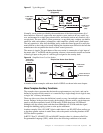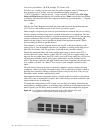
54 Handbook of Intercom Systems Engineering
your telephone; Call Bill, press the “Conf” button again; call Chuck, then press the
“CONF button, and you have a conference with all parties involved. With a matrix
intercom system, you press the talk keys assigned to Alice, Bill and Chuck and say “Meet
me on Tech PL”. You, Alice, Bill and Chuck each press “Tech PL” on your user station,
and instant conference.
Other types of specialized communications can be established as easily (or easier) in a
matrix intercom system. These types include the following:
Conference or PL – described above
Isolate or ISO – a temporary private discussion amongst two parties
IFB – Temporary interruption of a program signal with private conversation
Special List or Group Call – Single key to address many individual users (also used as
“All Call”
Telephone – single key to answer an incoming telephone call, or to make an outgoing
telephone call (requires telephone interface, such as RTS™ TIF-2000).
Relay – pressing a given key activates a relay – a typical use would be to activate a
transmitter to send audio communications via wireless.
Ancillary Functions
Warning!
Low-key sales pitch …most modern matrices provide some form of ancillary functions. I
will describe those which are common to the matrices I have experience with, including
competitors of Telex, then I will delve into some functions which I know to be available in
the RTS™ line of Matrices including Zeus™, ADAM™, and ADAM™-CS intercom
systems.
The most common ancillary functions are those referred to under the heading of interfaces
or “GPI/O.” Quite often, in an intercom system, there is a need to interface to varying
degrees with the outside world, and the more complex the intercom system, the greater
need for such interfaces. Usually, these methods are quite predictable and the
manufacturers provide or recommend a solution. A good example is a telephone interface
that allows the intercom system to tie to the public telephone system to allow users to “dial
in” or be called by the intercom system.
Basic Ancillary Functions via GPI/O General Purpose Input / Output
Oftentimes the interface needed is not so predictable, a user may have a need for the
intercom system to flash a strobe light when calling into a high noise environment or to
activate a “gong” signal over a paging system to announce a message. For these purposes,
relays (one form of the “O” in GPI/O, which means “output”) can be wired from the
intercom system to the strobe or gong generator and programmed to activate when
required. Relays are not the only form of output available. A given system might instead
provide a logic level signal or an open collector signal from a transistor or opto-isolator.
The opposite need might also arise. A need for a signal, external to the matrix system, to
cause the intercom system to undertake a certain action. As defined previously, a user
station is a device that feeds a “port” of the matrix intercom system. At its most basic, it is
a “box” with three basic functions. First, it takes speech through a microphone, amplifies,
and processes it to a given signal format (balanced +8 dBu audio in RTS™ Matrices) to
feed the matrix. Second, it takes audio signals from the matrix (again. +8 dBu in RTS™
matrices) and converts them to a level suitable for driving a speaker. And third, it provides
some degree of signaling and control to the matrix. For example, something which says to
the matrix, “the user wishes to send his (or her) voice to FRED.”


















